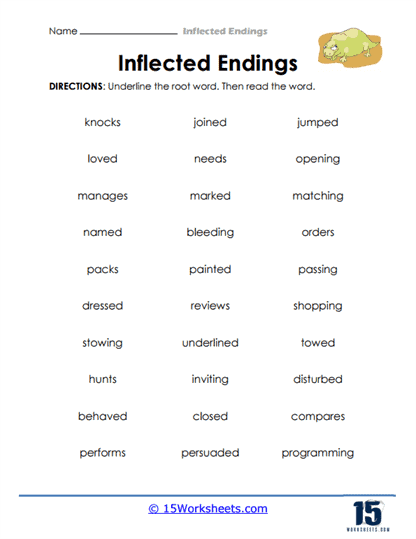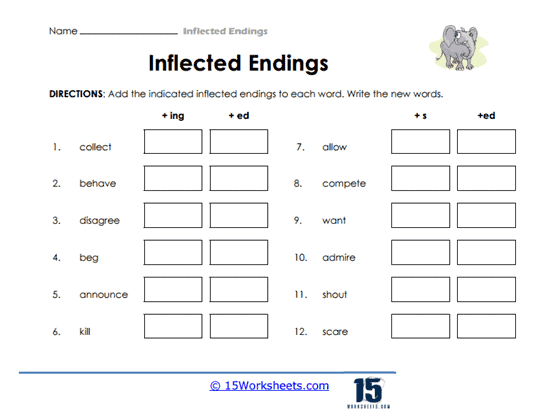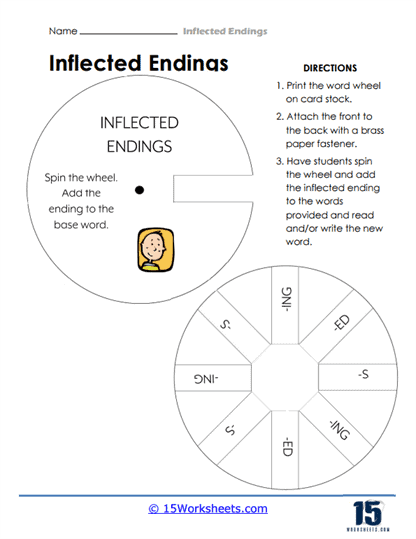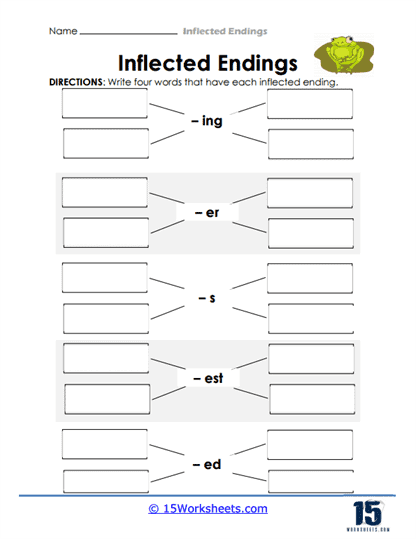Inflected Endings Worksheets
All About These 15 Worksheets
These worksheets teach students how to add common suffixes to root words in order to change their tense or grammatical function. These suffixes typically include -ed, -ing, and -s, which are crucial for transforming verbs based on time (past, present, and continuous), plurality, or action type. These worksheets cater to students learning the basics of English grammar and word formation, making them a fundamental resource for language development. They are used by teachers, tutors, homeschoolers, and anyone involved in early education or language learning, offering various activities that help reinforce the understanding of verb tenses and suffixes.
Types of Exercises
Adding Suffixes to Verbs – Students are provided with a list of base verbs and are asked to add appropriate inflected endings such as -ed (for past tense), -ing (for present continuous tense), or -s (for third-person singular in the present tense). This exercise is common across most of the inflected endings worksheets, and it helps students practice conjugating verbs based on the grammatical context.
Inflected Ending Matching Exercises – In some worksheets, students roll dice or spin wheels to randomly select a verb and an inflection (e.g., help + -ed, hike + -ing). They then write down the new word in a chart. This adds an element of playfulness to learning, engaging young learners with a fun, game-like activity. The first image you uploaded illustrates this kind of exercise with a chart that students complete after rolling dice to determine the base verb and inflection.
Identifying the Base Word – Students are given words that already include inflected endings and are asked to identify the root or base word (for example, from jumped, they would write jump). This reinforces their understanding of how inflected endings modify base words and improves their spelling and vocabulary skills. One of the worksheets in your set focuses on this, where students look at words like praying and slipped and write the root forms.
Conjugation Practice – Many worksheets feature lists of verbs that students must conjugate into different tenses. For example, they may be asked to change verbs like spill into spilled and spilling. This kind of exercise, seen in some of the images you uploaded, helps students understand how to form past tense and continuous tense forms of verbs, promoting mastery of irregular verbs as well.
Suffix Charts and Grids – Some worksheets provide grids where students fill in the appropriate suffix for a base verb. They may be required to add -ed, -ing, or -s to a list of base verbs in a structured way, such as writing push as pushed, pushing, and pushes. These grids help students see the patterns and relationships between different verb forms, aiding in memorization and retention of grammar rules.
Spelling Variations – In some activities, students learn spelling rules that apply when adding suffixes. For example, when a verb ends in e, like bake, the e is dropped before adding -ing to make baking. Similarly, double consonants are often used in verbs like trim, which becomes trimming. Some worksheets specifically focus on these spelling rules, allowing students to practice and apply them to various verbs.
Wheel or Dice-Based Learning – As seen in the last image, some worksheets incorporate physical activities, where students spin a wheel or roll dice to determine which inflected ending they will add to a given base word. This type of hands-on activity can make the learning process more interactive and engaging, particularly for younger students or those who benefit from tactile learning methods.
These worksheets are particularly useful for early learners (elementary level), ESL students, and anyone needing reinforcement in verb conjugation and grammar. Teachers and parents can use them as part of lesson plans, independent practice, homework, or small group activities. They can also be adapted for classroom games or interactive whiteboard activities. In homeschooling environments, these worksheets serve as a standalone practice tool or can be used in conjunction with other grammar lessons.
What Are Inflected Endings?
Inflected endings are suffixes added to the base form of a word to convey grammatical meaning, such as tense, number, or comparison. These endings can alter the function of the word without changing its core meaning. Common inflected endings include “-s,” “-ed,” “-ing,” and “-est.” They are essential components of English grammar, allowing speakers and writers to create variations of words to show actions in different tenses, pluralize nouns, or compare adjectives. Understanding how to read and use inflected endings is a foundational skill in mastering both reading fluency and writing.
Inflected endings play a crucial role in phonics, which is the method of teaching reading based on the sounds that letters and groups of letters make. For young learners, recognizing inflected endings helps with decoding words, which is key for developing fluent reading skills. By understanding how inflected endings attach to base words, students can more easily identify and pronounce new words, improve their spelling, and comprehend text better. For example, knowing that the “-ed” ending signifies past tense helps students decode a word like “walked” without having to memorize it separately.
Inflected endings also contribute to students’ grammatical awareness. When learners understand that adding an inflection changes the grammatical role of a word, they gain insight into sentence structure. For instance, adding “-ing” to a verb turns it into its present participle form, as in “running,” which signals an ongoing action. Similarly, adding “-s” to a noun indicates more than one, as in “cats.” This knowledge reinforces students’ understanding of how sentences are built and how meaning shifts with these small, yet powerful, changes.
Mastering inflected endings supports both reading and writing fluency. In reading, recognizing and pronouncing words with inflected endings becomes automatic with practice. This automaticity frees up cognitive resources to focus on comprehension. In writing, students who understand how to use inflected endings are able to write more complex sentences. They can properly convey ideas about time, number, and comparison, which allows them to express themselves more clearly and with greater precision.
Inflected endings are a vital phonics skill because they bridge the gap between basic word recognition and more advanced language use. When students learn to recognize and apply these endings, they gain greater flexibility in both understanding and producing language. This skill is crucial for their overall literacy development, as it helps them navigate more complex texts, construct grammatically accurate sentences, and engage in more nuanced communication. Mastering inflected endings enhances their ability to decode words efficiently and to grasp the full meaning of the sentences they read.
Examples of Inflected Endings
-ed – In the word “jumped,” the inflected ending “-ed” is added to the base word “jump” to indicate that the action occurred in the past.
-s – In the word “dogs,” the inflected ending “-s” is added to “dog” to show that the word is plural, meaning more than one dog.
-ing – In the word “running,” the inflected ending “-ing” is added to the base word “run” to indicate that the action is ongoing or happening in the present.
-es – In the word “watches,” the inflected ending “-es” is added to “watch” to show that the word is plural, meaning more than one watch.
-er – In the word “bigger,” the inflected ending “-er” is added to the base word “big” to show a comparative form, indicating that something is larger in size compared to something else.
-est – In the word “smallest,” the inflected ending “-est” is added to “small” to create the superlative form, indicating that it is the smallest in comparison to others.
-ly – In the word “quickly,” the inflected ending “-ly” is added to “quick” to turn the adjective into an adverb, describing how an action is performed.















